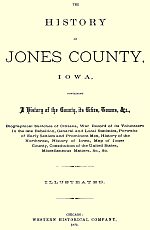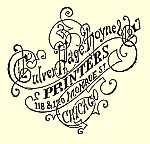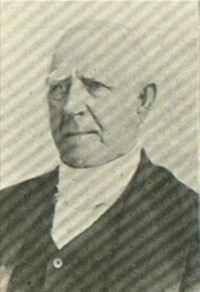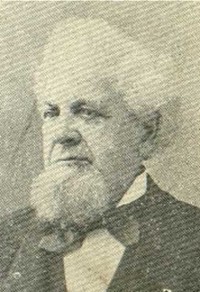



|
|
 "I would be glad to mention various associations that had an existence, but space forbids. Wyoming had its prosperous Lyceum, flourishing Literary and Library Association, Horse Protection Society, often called Vigilance Committee, its object being as stated in its constitution, 'to ferret out offenders and bring them to justice. "I would be glad to mention various associations that had an existence, but space forbids. Wyoming had its prosperous Lyceum, flourishing Literary and Library Association, Horse Protection Society, often called Vigilance Committee, its object being as stated in its constitution, 'to ferret out offenders and bring them to justice.
 * * * * * * * * * * * * * * * * * * * *
 The organization of these societies in all new countries is almost a necessity. They are a terror to evil-doers, and the horse-thief and blackleg flee from the 'wrath to come.' The organization of these societies in all new countries is almost a necessity. They are a terror to evil-doers, and the horse-thief and blackleg flee from the 'wrath to come.'
 * * * * * * * * * * * * * * * * * * * *
 "The old Iowa Mutual Insurance Company was formed here, just how early I cannot tell, but should say about 1857. Milton Briggs was the Company, and there were a few men they called Directors. The stock was represented by energy, perseverance, and determination, and its surplus capital was invested in what is commonly called 'cheek.' It was astonishing to see what an amount of this commodity could be bought with so small a surplus. It was a good thing for Wyoming, and brought to our town many men and considerable money. It loaned money, and when its affairs were wound up, there was no one to receive its indebtedness, or look after it, and that clever old statute of limitations paid it. It favored the education of the young, and for this purpose built a large schoolhouse in our town, and would have made it more ornamental, if it had not been for short-sighted School Directors. It discharged its obligation with fidelity and paid its losses promptly. It might have been doing business yet, but it was alleged that legislation was unfriendly, and its affairs had better be wound up. "The old Iowa Mutual Insurance Company was formed here, just how early I cannot tell, but should say about 1857. Milton Briggs was the Company, and there were a few men they called Directors. The stock was represented by energy, perseverance, and determination, and its surplus capital was invested in what is commonly called 'cheek.' It was astonishing to see what an amount of this commodity could be bought with so small a surplus. It was a good thing for Wyoming, and brought to our town many men and considerable money. It loaned money, and when its affairs were wound up, there was no one to receive its indebtedness, or look after it, and that clever old statute of limitations paid it. It favored the education of the young, and for this purpose built a large schoolhouse in our town, and would have made it more ornamental, if it had not been for short-sighted School Directors. It discharged its obligation with fidelity and paid its losses promptly. It might have been doing business yet, but it was alleged that legislation was unfriendly, and its affairs had better be wound up.
 "In the spring of 1856, Thomas Green and Mr. Bodenhoffer built a steam mill in the north part of the township. It has been torn down and removed. It furnished lumber for most of the buildings that were being erected at that time, and there is not a farm for miles around but what is fenced with lumber, more or less of it coming from that mill. "In the spring of 1856, Thomas Green and Mr. Bodenhoffer built a steam mill in the north part of the township. It has been torn down and removed. It furnished lumber for most of the buildings that were being erected at that time, and there is not a farm for miles around but what is fenced with lumber, more or less of it coming from that mill.
 "In our early history, all merchandise was brought in wagons from various points on the Mississippi River; afterward, London became the great shipping point. In wet seasons, it was a severe task to get across the Wapsie Valley and over some of the miry sloughs, both this side and beyond. For years, we looked and hoped for a railroad connection directly east. At length, with aid to the amount of $40,000, the Davenport & St. Paul road was finished through our town in the year 1871. "In our early history, all merchandise was brought in wagons from various points on the Mississippi River; afterward, London became the great shipping point. In wet seasons, it was a severe task to get across the Wapsie Valley and over some of the miry sloughs, both this side and beyond. For years, we looked and hoped for a railroad connection directly east. At length, with aid to the amount of $40,000, the Davenport & St. Paul road was finished through our town in the year 1871.
 * * * * * * * * * * * * * * * * * * * *
 "The Midland Railroad was finished through the north part of the township the same year, and the town of Onslow commenced. By the two railroads, our citizens have access to all points, north, east, south and west. "The Midland Railroad was finished through the north part of the township the same year, and the town of Onslow commenced. By the two railroads, our citizens have access to all points, north, east, south and west.
 * * * * * * * * * * * * * * * * * * * *
 "The first doctor who lived on this town plot was Dr. Edwards. He came in the spring of 1856. Of his antecedents, I know nothing; of his skill, I am entirely ignorant; but it was said he bought a fine pacing horse of Nick Countryman. One day, he paced out of town, and Nick's estate would be glad to know if he is pacing yet. "The first doctor who lived on this town plot was Dr. Edwards. He came in the spring of 1856. Of his antecedents, I know nothing; of his skill, I am entirely ignorant; but it was said he bought a fine pacing horse of Nick Countryman. One day, he paced out of town, and Nick's estate would be glad to know if he is pacing yet.

James A. Bronson |

S. K. Tourtellot |

Thomas Green |

R. S. Williams |
 "Among the first merchants were J. A. Bronson, Irving Green, Gilbert & Kelly, Hendricks & King, B. K. Bronson, S. M. Bronson, A. G. Brown, A. Bronson, S. K. Tourtellot, J. B. Allen, Hezekiah Moore, Charles Gilbert and George Foote, Benjamin Stiles, L. D. & D. E. Brainard. The first tinner's name was White, and his shop was in the back part of A. H. Persons' house. The latter was the first artist in the town, and his rooms were in the house of Mr. Thomas Green. R. S. Williams was the first successful brickmaker, and to him Wyoming is greatly indebted for its brick blocks and dwellings. His stores, halls and galleries, and shops of various kinds, speak of merited success. The first hotels were kept by Brainards, and in the business they got up a corner. Uncle Ansel and Daniel E. were cornered where the Valley House stands, and Nial and his sons were cornered where the Bissell House stands, and L. D. was cornered out on the prairie, a mile east of town, but running a hotel. "Among the first merchants were J. A. Bronson, Irving Green, Gilbert & Kelly, Hendricks & King, B. K. Bronson, S. M. Bronson, A. G. Brown, A. Bronson, S. K. Tourtellot, J. B. Allen, Hezekiah Moore, Charles Gilbert and George Foote, Benjamin Stiles, L. D. & D. E. Brainard. The first tinner's name was White, and his shop was in the back part of A. H. Persons' house. The latter was the first artist in the town, and his rooms were in the house of Mr. Thomas Green. R. S. Williams was the first successful brickmaker, and to him Wyoming is greatly indebted for its brick blocks and dwellings. His stores, halls and galleries, and shops of various kinds, speak of merited success. The first hotels were kept by Brainards, and in the business they got up a corner. Uncle Ansel and Daniel E. were cornered where the Valley House stands, and Nial and his sons were cornered where the Bissell House stands, and L. D. was cornered out on the prairie, a mile east of town, but running a hotel.
 "I have mentioned the earliest settlers, or those who came in 1839 and 1840. It is a short list and I repeat it: James Van Voltenbergh, with his sons Joseph, Taylor, Peter and Dan, David Pence, William Knight, Garrisons, Simpsons. "I have mentioned the earliest settlers, or those who came in 1839 and 1840. It is a short list and I repeat it: James Van Voltenbergh, with his sons Joseph, Taylor, Peter and Dan, David Pence, William Knight, Garrisons, Simpsons.
 * * * * * * * * * * * * * * * * * * * *
 "In 1842, John B. Nichols, the father of our druggist, moved on what is now called South Prairie, and located on the farm now owned by Mr. John Byerly. He was the first settler in that vicinity. In the summer of 1842, he cut logs, and drew them out on the prairie for a house. His farming occupying his time for a few days, his track on the prairie was no longer visible, and he lost his logs. A second lot of logs shared the same fate. When he drew the third set, he took occasion to mark the road so that he could find them. You can judge that there was pretty tall grass over there. He is said to have killed seventeen rattlesnakes one morning before breakfast. "In 1842, John B. Nichols, the father of our druggist, moved on what is now called South Prairie, and located on the farm now owned by Mr. John Byerly. He was the first settler in that vicinity. In the summer of 1842, he cut logs, and drew them out on the prairie for a house. His farming occupying his time for a few days, his track on the prairie was no longer visible, and he lost his logs. A second lot of logs shared the same fate. When he drew the third set, he took occasion to mark the road so that he could find them. You can judge that there was pretty tall grass over there. He is said to have killed seventeen rattlesnakes one morning before breakfast.
 "In 1844, Joel B. Taylor and Seaborn Moore moved here. Taylor located where Peter Byerly lives; his father came a few years later. Seaborn Moore was formerly from Georgia; but he had been living in Indiana and Illinois long enough to get himself and family thoroughly filled with a real genuine ague, and he left that country to find a spot where the ague was unknown. Those of you who know where he located will readily conclude that the ague would never find him. It was a very secluded spot in the northeast corner of the township. There were two ways to get there. You could follow up a narrow, crooked, rocky ravine from toward Monmouth, or you could go over through the brush toward Canton. No matter which way you went, you could always tell when you were most to Esquire Moore's. When you had gone just about as far as you could get, you felt very certain that you were pretty near Mr. Moore's. There was no ague there. A pure spring of crystal water came up among the rocks. Lightning had a peculiar attachment for that place, and often manifested its power. There were in the family father, mother, seven boys and two girls. Some of them, however, were married, and all became stout and robust. In after life, five of those boys enlisted to fight the battles of their country and against the oppression of the native heath of their father. Those five boys were as successful in dodging rebel bullets on battle-fields as they had been heaven's artillery in the rocky ravine at home. Mr. Moore was the first Justice of the Peace in the township. "In 1844, Joel B. Taylor and Seaborn Moore moved here. Taylor located where Peter Byerly lives; his father came a few years later. Seaborn Moore was formerly from Georgia; but he had been living in Indiana and Illinois long enough to get himself and family thoroughly filled with a real genuine ague, and he left that country to find a spot where the ague was unknown. Those of you who know where he located will readily conclude that the ague would never find him. It was a very secluded spot in the northeast corner of the township. There were two ways to get there. You could follow up a narrow, crooked, rocky ravine from toward Monmouth, or you could go over through the brush toward Canton. No matter which way you went, you could always tell when you were most to Esquire Moore's. When you had gone just about as far as you could get, you felt very certain that you were pretty near Mr. Moore's. There was no ague there. A pure spring of crystal water came up among the rocks. Lightning had a peculiar attachment for that place, and often manifested its power. There were in the family father, mother, seven boys and two girls. Some of them, however, were married, and all became stout and robust. In after life, five of those boys enlisted to fight the battles of their country and against the oppression of the native heath of their father. Those five boys were as successful in dodging rebel bullets on battle-fields as they had been heaven's artillery in the rocky ravine at home. Mr. Moore was the first Justice of the Peace in the township.
 * * * * * * * * * * * * * * * * * * * *
 "John Tompkins came to Wyoming in 1846, and is one of the few who has retained his first location. Sarles Tompkins, the father of Stillwell, came in 1848. He or Thomas Green built the first barn in the township; both were built the same year. Mr. Tompkins was killed while trying to load a log on to a sled in 1862. John T. Lain, the father of Samuel, came into Wyoming in 1849, and located on the farm now owned by Roderick Spencer. He sold his claim afterward to Sweet and Lindsay, who claimed to be doctors; but it is said to be a question whether they were engaged in that laudable business or stealing horses. He died some years ago. His widow is still in our midst, tottering under the infirmities of age. "John Tompkins came to Wyoming in 1846, and is one of the few who has retained his first location. Sarles Tompkins, the father of Stillwell, came in 1848. He or Thomas Green built the first barn in the township; both were built the same year. Mr. Tompkins was killed while trying to load a log on to a sled in 1862. John T. Lain, the father of Samuel, came into Wyoming in 1849, and located on the farm now owned by Roderick Spencer. He sold his claim afterward to Sweet and Lindsay, who claimed to be doctors; but it is said to be a question whether they were engaged in that laudable business or stealing horses. He died some years ago. His widow is still in our midst, tottering under the infirmities of age.
 "S. C. Bill, O. J. Bill, L. D. Brainard and G. W. Fawcett came in 1851, and located on Pleasant Ridge, and chained their wagons to the trees to keep them from blowing away. They had heard of Iowa's balmy breezes and thought they would anchor their prairie schooners to some trees and thus secure a footing on terra firma. They were the first settlers on that ridge, and came from Ohio. They had traveled from the Buckeye State in wagons, during one of the wettest seasons ever known, and when they got on to that ridge, they probably thought it like Mount Ararat, and they took possession of it. L. D. Brainard pitched his tent on the Stephen Hamilton farm; also entered some timber-land in the east part of the township. This timber had been claimed by some one from Jackson County, and the Claim Society from that county came up to notify L. D. that he must get off that land. He heard what they had to say, and then in language almost profane said, 'By the long wars, we have six rifles and plenty of ammunition. You undertake to drive me away from here and we will show you that we know how to use them.' "S. C. Bill, O. J. Bill, L. D. Brainard and G. W. Fawcett came in 1851, and located on Pleasant Ridge, and chained their wagons to the trees to keep them from blowing away. They had heard of Iowa's balmy breezes and thought they would anchor their prairie schooners to some trees and thus secure a footing on terra firma. They were the first settlers on that ridge, and came from Ohio. They had traveled from the Buckeye State in wagons, during one of the wettest seasons ever known, and when they got on to that ridge, they probably thought it like Mount Ararat, and they took possession of it. L. D. Brainard pitched his tent on the Stephen Hamilton farm; also entered some timber-land in the east part of the township. This timber had been claimed by some one from Jackson County, and the Claim Society from that county came up to notify L. D. that he must get off that land. He heard what they had to say, and then in language almost profane said, 'By the long wars, we have six rifles and plenty of ammunition. You undertake to drive me away from here and we will show you that we know how to use them.'
 * * * * * * * * * * * * * * * * * * * *
 "He never heard of that Claim Society again. Brainard built a saw-mill on Bear Creek, which was the first in this vicinity. He went West several years ago. W. H. Holmes and Amos Robbins came the same year. The latter shot himself a few years later. Mr. Holmes is still in our midst. At the first election in the township, he was elected Justice of the Peace; has since been Representative, Senator, County Judge and State Treasurer, and is now our obliging Postmaster." "He never heard of that Claim Society again. Brainard built a saw-mill on Bear Creek, which was the first in this vicinity. He went West several years ago. W. H. Holmes and Amos Robbins came the same year. The latter shot himself a few years later. Mr. Holmes is still in our midst. At the first election in the township, he was elected Justice of the Peace; has since been Representative, Senator, County Judge and State Treasurer, and is now our obliging Postmaster." |
|


|



















